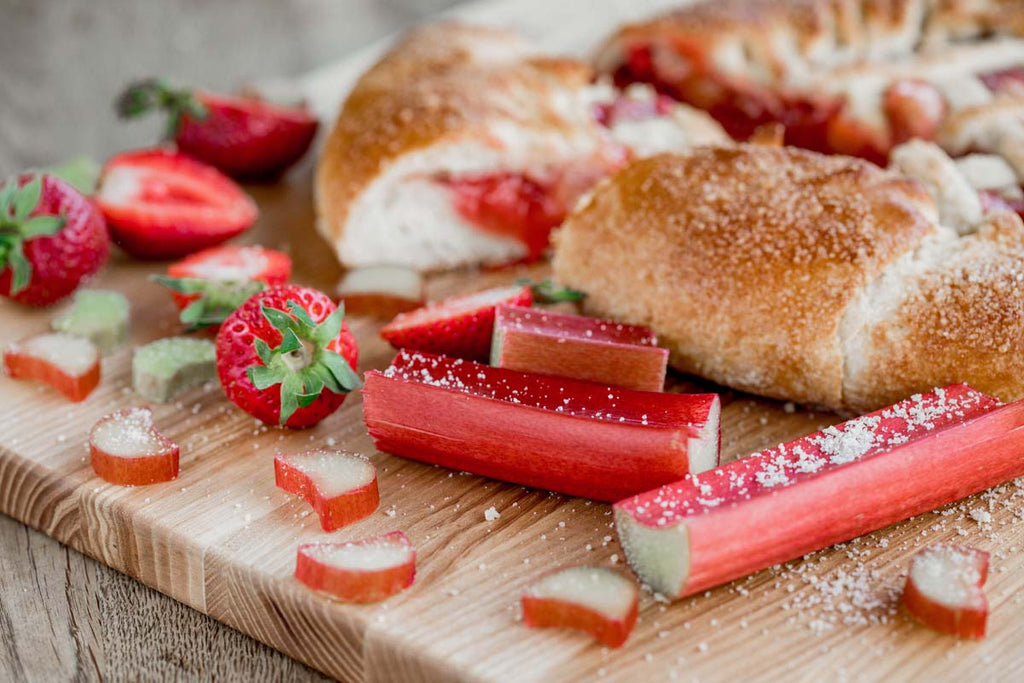Ravent: Mutfak, Tıbbi ve Tarihsel Bir Harika

Canlı ekşiliği ve çok yönlülüğü ile tanınan rabarba, yüzyıllardır mutfak hayal gücünü yakalamıştır. Genellikle meyve sanılan bu olağanüstü sebze, sadece benzersiz bir tat sunmakla kalmaz, aynı zamanda sağlık faydaları açısından da bir hazine sunar. Tarihçesi, büyümesi, tadı, tıbbi kullanımları, mutfak potansiyeli ve en iyi saklama uygulamaları hakkında bir yolculuğa çıkalım.
Rabarbanın Tarihi: Zaman İçinde Bir Sap
Rabarbanın (Rheum rhabarbarum) Çin'de, özellikle Sibirya ve Moğolistan bölgelerinde ortaya çıktığına inanılmaktadır. Tarihsel ve botanik kanıtlar, rabarbanın binlerce yıldır Çin tıbbında kullanıldığını göstermektedir.
Rabarbanın kullanımına dair en eski kayıtlar, bitkinin kökleri ve rizomlarının tıbbi özellikleri için kullanıldığı eski Çin'e kadar uzanır. Rabarba, geleneksel Çin tıbbında öncelikle müshil ve çeşitli gastrointestinal rahatsızlıklar için kullanılmıştır.
Ayrıca, rabarba, yaklaşık MÖ 200-300 yıllarına tarihlenen en eski bilinen Çin tıbbi metinlerinden biri olan "Shennong Ben Cao Jing" (Shennong'un Bitkisel Klasikleri) gibi eski Çin metinlerinde belgelenmiştir. Bu metin, rabarbanın tıbbi özelliklerinden ve geleneksel Çin tıbbındaki kullanımından bahsetmiştir.
Zamanla, ticaret yolları boyunca yayıldı ve hem tıbbi hem de mutfak kullanımları için popülerlik kazanarak Avrupa'ya ulaştı. Tarih boyunca geçirdiği yolculuk, bugün küresel varlığını şekillendirdi.

Rabarbanın Büyümesi ve Hasadı
Soğuk mevsim sebzesi olan ravent, iyi drene edilmiş toprak ve bol güneş alan ılıman bölgelerde gelişir. Yayılım, köklerin bölünmesi veya taçların dikilmesiyle olur. Hasat, saplar sert, kalın ve canlı renkte olduğunda, geç ilkbahardan erken yaz aylarına kadar başlar ve mutfak maceraları için bol verim sağlar.


Ravent'in Eşsiz Tadı ve Mükemmel Eşlikçiler
Ravent, pişirildiğinde ve tatlandırıldığında dönüşen kendine özgü, ekşi tadıyla ünlüdür. Ekşilik ve hafif tatlılık dengesi, onu birçok mutfak uygulaması için ideal kılar. Raventi çilek gibi tatlı meyveler, tarçın ve zencefil gibi baharatlar ve şeker veya bal gibi tatlandırıcılarla eşleştirerek tadını yükseltebilir ve lezzetli yemekler yaratabilirsiniz.
Otlar ve baharatlar, raventin ekşiliğini tamamlayabilir ve yemeklerinize lezzet derinliği katabilir. İşte raventle iyi uyum sağlayan bazı otlar:
-
Zencefil: Zencefilin baharatlı ve aromatik notaları, özellikle reçel, sos ve tatlılarda raventin ekşiliğini tamamlar.
-
Tarçın: Tarçın, ravent bazlı yemeklere sıcaklık ve hafif tatlılık katar, turta, çıtır tatlılar ve kompostolar için mükemmel bir eşlikçidir.
-
Vanilya: Vanilyanın tatlı, çiçeksi notaları, raventin ekşiliğini dengeler, turta, sos ve fırın ürünlerinde tadını artırır.
-
Nane: Taze nane yaprakları, raventle salatalarda, içeceklerde veya meyve kompostolarında eşleştirildiğinde ferahlatıcı ve aromatik bir unsur sağlar.
-
Limon Kekiği: Limon kekiği, narenciye notalarıyla raventi tamamlar, reçeller, soslar ve kokteyllere parlak ve canlı bir tat katar.
-
Lavanta: Lavantanın çiçeksi ve hafif tatlı aroması, reçel, çıtır tatlılar veya dondurmalar gibi ravent bazlı tatlılara benzersiz bir dokunuş olabilir.
-
Biberiye: Biberiyenin çam kokulu, bitkisel tadı, tuzlu yemeklerde, chutneylerde veya fırınlanmış sebze karışımlarında ravente karmaşıklık katabilir.
- Portakal Kabuğu Rendesi: Portakal kabuğu rendesinin parlak, narenciye notaları, özellikle tatlılar, reçeller ve soslarda raventin ekşiliğini tamamlayabilir.
- Kakule: Kakulenin sıcak, aromatik ve hafif baharatlı tadı, turta ve kırıntı gibi raventli tatlılara derinlik ve karmaşıklık katabilir.
Bu otlar ve baharat kombinasyonlarıyla deneyler yaparak damak tadınıza ve hazırladığınız yemeğe en uygun karışımları bulun. Tatlı ya da tuzlu olsun, otlar eklemek raventli tariflerinizin genel tadını ve aromasını yükseltebilir.

Ravent'in Sağlık Faydaları
Lezzetli tadının ötesinde, ravent birçok sağlık faydası sunar:
Besin açısından zengin: K vitamini, C vitamini, kalsiyum, potasyum ve diyet lifi gibi temel besinlerle dolu olan ravent, genel sağlık ve iyi oluşu destekler.
Digestive Health: The fiber content in rhubarb aids digestion, promoting regular bowel movements and potentially relieving constipation.
Antioxidant Properties: Rhubarb contains antioxidants such as anthocyanins and polyphenols, which neutralize harmful free radicals and reduce the risk of chronic diseases.
Potential Anti-Inflammatory Effects: Studies suggest that compounds in rhubarb may have anti-inflammatory properties, which could be beneficial in managing inflammatory conditions.
Blood Sugar Management: Rhubarb may assist in blood sugar regulation due to its fiber content and potential to improve insulin sensitivity.

Rabarba ile Pişirme: Bir Mutfak Macerası
Rabarbanın mutfak potansiyelini bu lezzetli yemeklerle keşfedin:
Rhubarb Pie: Combine rhubarb with sugar and other fruits for a classic pie that's both tart and sweet.
Rhubarb Sauce: Stew rhubarb to create a versatile sauce, perfect as a topping or a complement to meats.
Rhubarb Crisp: Pair tart rhubarb with a sweet, crumbly oat topping for a comforting dessert.
Rhubarb Compote: Simmer rhubarb with sugar and spices to create a delightful compote for various dishes.
Rhubarb Smoothies: Blend rhubarb with other fruits and vegetables for a nutritious and refreshing smoothie.

Rabarbayı Tazeliği İçin Saklama
Rabarbanın tazeliğini korumak için:
Refrigeration: Wrap fresh rhubarb in a damp paper towel, place in a plastic bag, and store in the refrigerator for up to a week.
Freezing: Chop rhubarb into small pieces and freeze for long-term storage, allowing its use throughout the year.
Canning: Preserve rhubarb by canning it into jams, sauces, or compotes for extended shelf life.

Rabarba, zengin tarihi, benzersiz tadı ve sağlık faydalarıyla doğanın harikalarının bir kanıtı olarak duruyor. Bu olağanüstü sebzenin potansiyelini kucaklayın ve tadını çıkarırken genel sağlığınıza katkıda bulunmasına izin verin. Mutlu pişirmeler ve rabarbanın keyfini çıkarın!
















Yorum bırak